American Military Patches, Other Insignia and Decorations of World War Two by Dr. Howard G. Lanham c.2011
Evolution of United States Army Artillery Insignia
Artillery Officer's Uniform 1786
By H. Charles McBarron
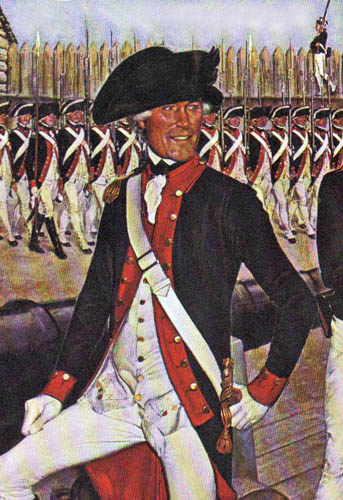
|
|
Artillery Officer's Uniform 1827
By H. Charles McBarron
Notice gold uniform accents.
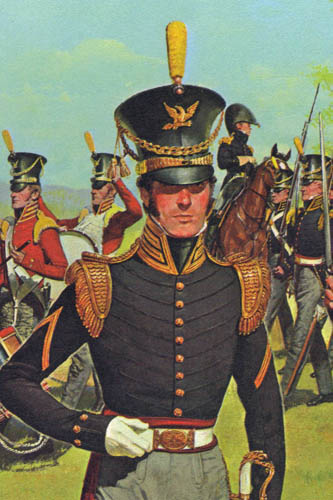
|
|
The Artillery branch of the Continental Army was established by the Continental Congress on November 17, 1775, with the appointment of Henry Knox as the colonel of the Regiment of Artillery. The nucleus of the regiment was Massachusetts State Train of Artillery that was established on May 10, 1775 and commanded by Colonel Richard Gridley. The Massachusetts Regiment was consolidated with the Rhode Island Train of Artillery as the new Continental Artillery Regiment on January, 1 1776. Although an experienced artillerist and military engineer, Colonel Gridley was 65 years-old and not equal to prolonged field service. He was retained as Chief Engineer of the Eastern Department once replaced by Knox. Knox proved to be energetic and resourceful and just the man Washington needed. With great difficulty Knox transported 60 tons of artillery from the captured British Fort Ticonderoga across Massachusetts to Boston in the winter of 1776. Shocked at seeing Dorchester Heights bristling with Patriot artillery, the British evacuated Boston and Knox's accomplishment became part of Revolutionary War legend.
Example of a Shako Eagle
(This may be a restrike from the original die.)
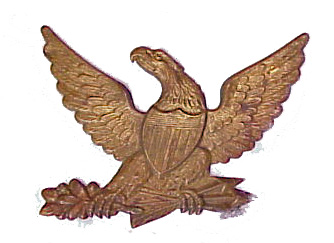
|
|
Early Crossed Cannon Insignia

|
|
An Ancient and Honorable Company of Artillery Button
|
| 
|
At the end of the Revolutionary War only a few artillery companies were retained in the service. In 1789 these were organized into a battalion with the ranking U.S. artillery officer to be the Major Commandant. In 1794 Congress combined The Corps of Engineers and Artillery into a single branch. This situation lasted until 1802 when they were again separated. In the years that followed artillery units were repeatedly reorganized and renamed. Beginning with the reorganization of 1821 and the formation of four regiments of artillery that year, there was a period of stability that lasted until the Civil War. In 1832 the Ordnance branch was created mostly from former elements of artillery. Artillery units were equipped as foot, horse or fortress with the horse artillery being the most mobile and the fortress the least. They were scattered in small units over a wide area of forts and posts, mostly on the Eastern seaboard but there were some units on the Canadian border, and western U.S. In addition to the Regular Army establishment there were also a number of states, which had militia units designated as artillery. However, many of these units were artillery in name only or even small artillery detachments within larger infantry regiments. The oldest of the militia units is the Ancient and Honorable Company of Artillery of the State of Massachusetts founded in 1638.
Artillery Private with Hat Insignia
Civil War Period
Courtesy: Bob Borrell
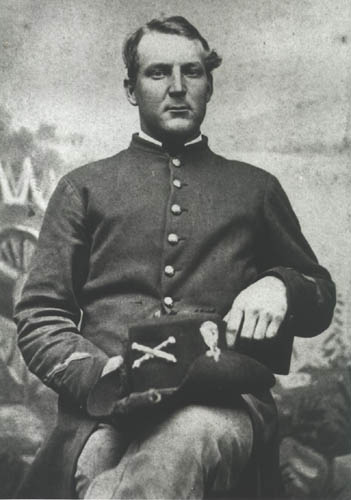
|
|
Prior to 1851 U.S. Army insignia and uniform features; such as buckles, buttons, epaulettes and even sword hilts, followed that is referred to as the bimetallic system. Basically this was what infantry units had white or silver colored infantry accents while other branches of which artillery had the largest number of troops had gold or brass colored uniform accents. The bimetallic system disappeared with the revolutionary uniform regulations issued in 1851. The 1851 Regulations set up a system of branch insignia and branch colors many of which are still features of modern U.S. Army uniforms. There is only one counterintuitive legacy of the bimetallic system still reflected in U.S. army insignia (which I have fully explained elsewhere): the rank insignia of majors and second lieutenant are gold colored, a more noble color than the silver of higher ranking lieutenant colonels and first lieutenants. The 1827 print by McBarron above shows an artillery officer with many of the gold colored uniform features mentioned above. The crossed cannon insignia of artillery first appeared as an individual insignia in 1834 and was worn on the shako or cap of the period underneath a U.S. eagle.
In 1858 the Army introduced a brimmed hat and redesigned the enlisted crossed cannon insignia to have much longer barrels. Officers wore embroidered crossed cannons on their shakos beginning in 1851 and these insignia were transferred to the their hats in 1858. During the Civil War crossed cannon insignia were often worn both by officers and enlisted men on the tops or fronts of their forage caps (also called kepis). During the Civil War many volunteer batteries were formed by the various states and the artillery of the Federal army made a significant contribution to the victory of the Union army.
Regulation Enlisted Artillery Insignia 1851-1872

|
|
False Embroidered Crossed Cannon Insignia (Private Purchase)
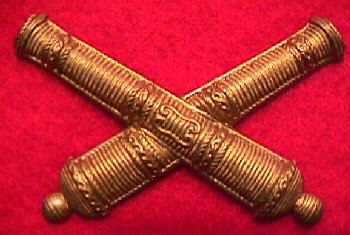
|
|
|
At the close of the Civil War the volunteers were discharged and there was little role for the Regular Army artillery branch during the Indian Wars. The artillery branch languished in garrison duty. During Spanish American War of 1898 the Spanish had superior modern artillery pieces acquired from Krupp. The entire Army entered the 20th Century with a focus on modernization. In 1901 the artillery branch was reorganized and field artillery and coast artillery because separate service branches. The crossed cannon insignia worn during the Civil War gave way to a somewhat smaller version in 1872. In 1881 a dress helmet was adopted that had a large eagle with crossed cannons and a shield on its chest. In 1895 officers began wearing branch insignia on their collars. In 1902 the coast artillery officers were given a special branch insignia with an artillery shell in an oval at the intersection of the cannon. The 1902 regulations also authorized crossed cannon for enlisted men's collars and in 1905 the insignia was redesigned making the cannon smaller. In 1910 enlisted collar disks made their debut. In 1917 coast artillery enlisted men were prescribed a collar disk with the same insignia as their officers. Prior to that time they wore a disk with crossed cannons and the company number below.
Enlisted Artillery Helmet Plate 1881-1902

|
|
Artillery Soldier of Battery D of the First Artillery Regiment
Oahu, Hawaii 1913 He is wearing the smaller insignia of 1905.

|
|
Enlisted Artillery Hat Insignia 1872-1895

|
|
Enlisted 2nd Artillery Collar Insignia 1902-1905

|
|
Enlisted 7th Artillery Hat Insignia 1901-1905

|
|
Enlisted 90th Artillery Collar Insignia 1902-1905

|
|
Enlisted Hat Insignia for Battery C of the 4th Artillery Regiment 1905-1917
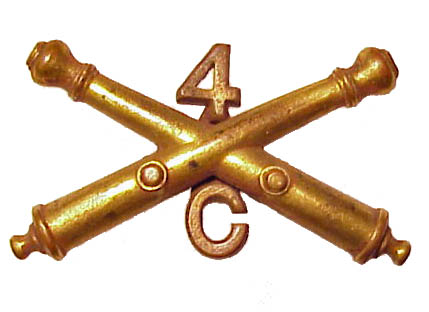
|
|
The United States entered World War One in 1917 and a large number of artillery units were formed. Among the veterans of artillery service was future President Harry S Truman, who served in the 129th Field Artillery Regiment. The ordnance used was mostly French manufactured 75mm field guns, which were still horse drawn. An effort was made to train American officers at French schools of instruction before committing them to combat. Artillery service was nearly as dangerous as infantry and a battery caught in the open could expect a barrage of deadly counter battery fire from the German artillery. With the declaration of the armistice the various American units fired off a last round competing for the curious distinction of firing the last shot of the war.
American branch insignia used during World War One was rather uniform and all had a dull bronze finished that appears not dissimilar to the modern subdued metallic branch insignia first worn during the Vietnam area. Officers wore crossed cannon collar insignia and enlisted men wore collar disks. The schema of the collar disks changed such that the crossed cannon disk may or may not have either the regimental number or battery letter or may have both. Toward the end of the war disks were supplied in pairs with the U.S. and regimental number worn on the right side and crossed cannons and battery letter worn on the right. Coast artillery officers continued using insignia similar to field artillery but with the oval and shell in the center and coast artillery enlisted men were given the same device on their disks beginning in 1917. During the war the Army replaced branch hat insignia with a large disk having the U.S. eagle for all branches and after that time branch insignia (with some sporadic exceptions, such as the sides of some overseas caps or the cuff of officer's mess dress coats) were exclusively worn on collars or lapels.
Artillery Officer's Collar Insignia
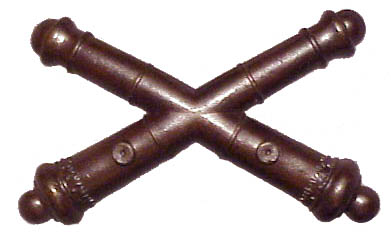
|
|
Coast Artillery Officer's Collar Insignia
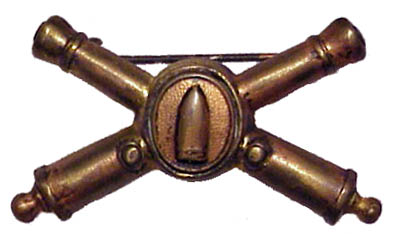
|
|
Enlisted Artillery Disk
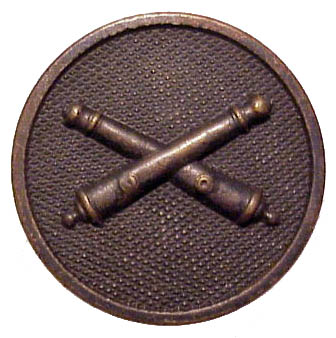
|
|
Coast Artillery 124th Company
1910-1917

|
|
Enlisted Disk for Battery B of the 309th Artillery Regiment
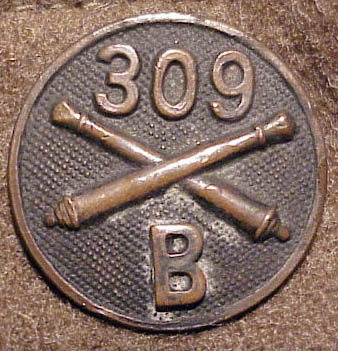
|
|
Enlisted Disk for Battery E of the 325th Artillery Regiment
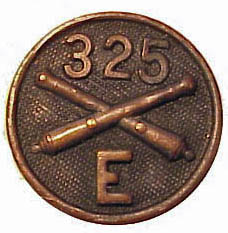
|
|
Enlisted Disk for Battery E

|
|
World War One ended and once again there was a reduction of forces. However, those artillery officers retained in the service all had the experience of modern war and there was a focus on mechanization and modernization, which was not totally completed until 1942. Field guns were also improved and with the outbreak of the Second World War America would have first rate artillery pieces and would not once again fight a war using another nation's field guns. Commentators often remark on the relative superiority of German armored vehicles but the superiority of American artillery seems appreciated only by the poor Axis soldiers who endured it. There also were changes in insignia between the two wars. In 1924 Army uniform insignia were changed to a gilt or brass color and the dull bronze of World War One was discontinued. In 1926 the standing collar coat was replaced by lapel collars and insignia moved to the lapels of the coat and given smaller dimensions.
Enlisted Artillery Disk Battery F

|
|
Enlisted Artillery Disk Service Company

|
|
Coast Artillery Enlisted Disk

|
|
In 1941 the Japanese attacked Pearl Harbor and the nation was once again at war. There was a massive mobilization with ten and one-half million soldiers serving in the U.S. Army. These men and women found themselves circling the globe in what was truly a world war. The nation that emerged at the end of the war was not the nation that entered the war and the historical developments set in motion by this war still have some momentum even as the number of survivors of the conflict dwindle in numbers. While there was an effort to provide insignia that had camouflage valve during World War One, it was decided that the small brass insignia on the service uniform coat were not that visible but practice most front line soldiers wore field uniforms that lacked brass insignia. World War One insignia were attached by screw posts and retaining nuts or by pins on the back. During World War Two clutch fasteners became very common although the older means were still in use as well. World War Two officer's insignia are slightly smaller than their World War One counterparts, with the exception of those World War One ones that were intended to be worn of shirt collars. There was less of an effort to display unit numbers or letters on insignia and most artillerymen wore plain crossed cannon. The insignia of coast artillery officers had been changed in the 1920s to one with a red enamel oval surrounding the shell at the intersection of the cannons rather than a brass colored oval.
Field Artillery Officer's Lapel Insignia
In this variation there are smaller tubes.
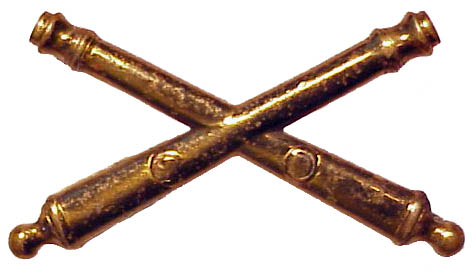
|
|
Field Artillery Officer's Lapel Insignia
In this variation there are larger tubes.
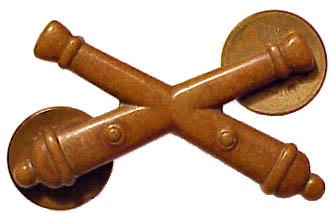
|
|
4th Coast Artillery Regiment Officer's Lapel Insignia 1924-1950
This unit was stationed at Fort Armador, Panama Canal Zone.
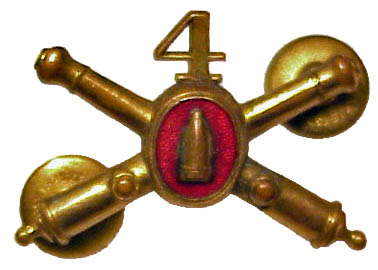
|
|
|
|
|
Coast Artillery Enlisted Disk Company B Prewar to Early War Type
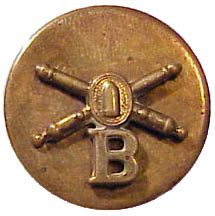
|
|
Coast Artillery Enlisted Disk Mid to Late War One-piece Type

|
|
The Second World War ended in 1945 and major technological innovations redefined the projection of munitions. The military entered the missile age In 1950 the coast artillery was merged into the artillery branch and its separate insignia discontinued. In 1957 the design of artillery branch insignia was changed to incorporate a missile. In 1968 this insignia was reserved for Air Defense Artillery only and field artillery units once again wore crossed cannons. Subdued insignia were first worn during the Vietnam conflict and exist in either cloth or metallic versions.
424th Artillery Battalion Officer's Lapel Insignia
Post-World War Two Manufacture
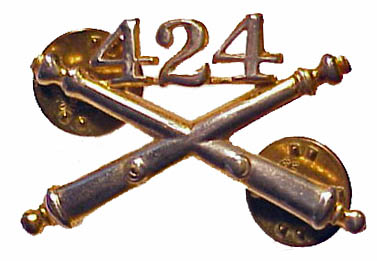
|
|
Air Defense Artillery Officer's Lapel Insignia
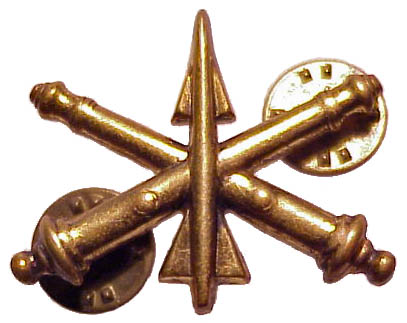
|
|
Domed Type Enlisted Coast Artillery Disk
This style was popular in late 1940s and privately purchased.

|
|
Enlisted Man's Air Defense Artillery Disk
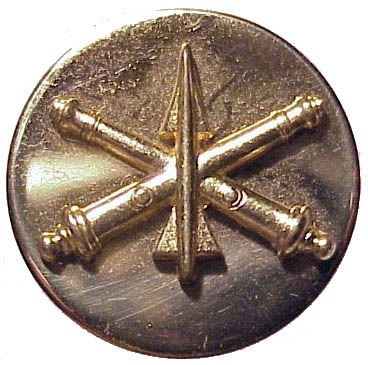
|
|
All images are either public domain or from the author's collection.
The various dates of use I list are my approximations and subject to error.
Evolution of U.S. Army Cavalry Insignia
Evolution of U.S. Army Infantry Insignia
Back to Insignia of World War Two
Back to Uniforms of the Civil War


